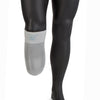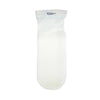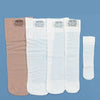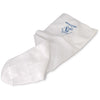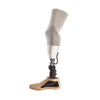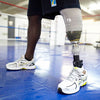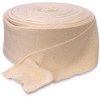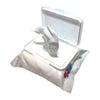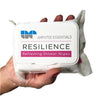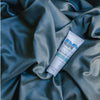Help! I'm Constantly Sweating Inside My Prosthesis!
Have you noticed that you sweat more since amputation?
People who wear a prosthesis often notice that they sweat more than before, but they don't always know why. Sweating is part of everyone's natural cooling process, but amputees are particularly likely to sweat profusely, and that's for a couple of reasons.
First, the body's ability to cool itself is related to its overall skin surface area. When it's cold out, the blood vessels beneath the skin contract in order to keep the blood near the surface from getting too cold. When it's hot, the blood vessels expand to encourage heat loss -- that's what makes you sweat. Since a missing limb reduces the skin surface area, this natural cooling mechanism is less efficient.
Sweating is a sign that your body is working hard to control your core temperature. Since it takes more physical effort for amputees to get around -- which also means your body temperature is constantly on the rise -- you sweat more in response to everyday physical exertion. Normally, you'd cool off as the sweat evaporates from the surface of your skin. This isn't so easy when your limb is wrapped under layers of materials like liners, sheaths, and socks.
Sweating profusely is not only annoying, but for amputees it can be especially problematic. Aside from being uncomfortable, excessive sweating may cause or exacerbate friction sores and create a very unhygienic environment within your prosthetic socket.
Sweat is a mix of water, salt, and other minerals. There are two types of sweat: apocrine, a thick secretion found mainly in your underarms, and eccrine, a thin liquid that occurs all over the body when it's hot out or when you exercise. Eccrine sweat is the kind you're dealing with when you remove your prostheses and discover drenched prosthetic socks and a liner filled with a pool of sweat.
Sweat contains solids that accumulate in the socket of your prosthesis and on your limb. In the warm, moist socket environment, these solids become a breeding ground for the kind of bacteria that cause skin disorders. Sweat build-up inside a socket can also cause your limb to shift and slide around, which can cause chafing or abrasions.
The good news is that the body adapts to a hot environment like the inside of the socket by sweating more efficiently -- think of an athlete preparing for a race in Las Vegas by training in similar hot conditions. Over time, your body acclimates to wearing a gel suspension liner and will learn to moderate heat release. Many prosthetic users notice that they're sweating less within 4 months.
As an amputee, sweat control is essential to your hygiene, but the average deodorant or antiperspirant alone won't be an effective treatment. What you need is a multi-pronged approach that includes proper skin care, prosthetic textiles engineered for perspiration control, a properly fitting socket, and an antiperspirant formulated with prosthetic users in mind.
Related Articles:
- Don't sweat it! Vacuum Sockets
- When Nothing Else Works, Is Surgery An Option?
- What Are Sweat Control Prosthetic Textiles?
- Deodorant - A Primer
- Prosthetic Antiperspirant - A Primer
- Outsmart Sweat: How to Get Your Perspiration Under Control
- How Is That Different From Deodorant?














































